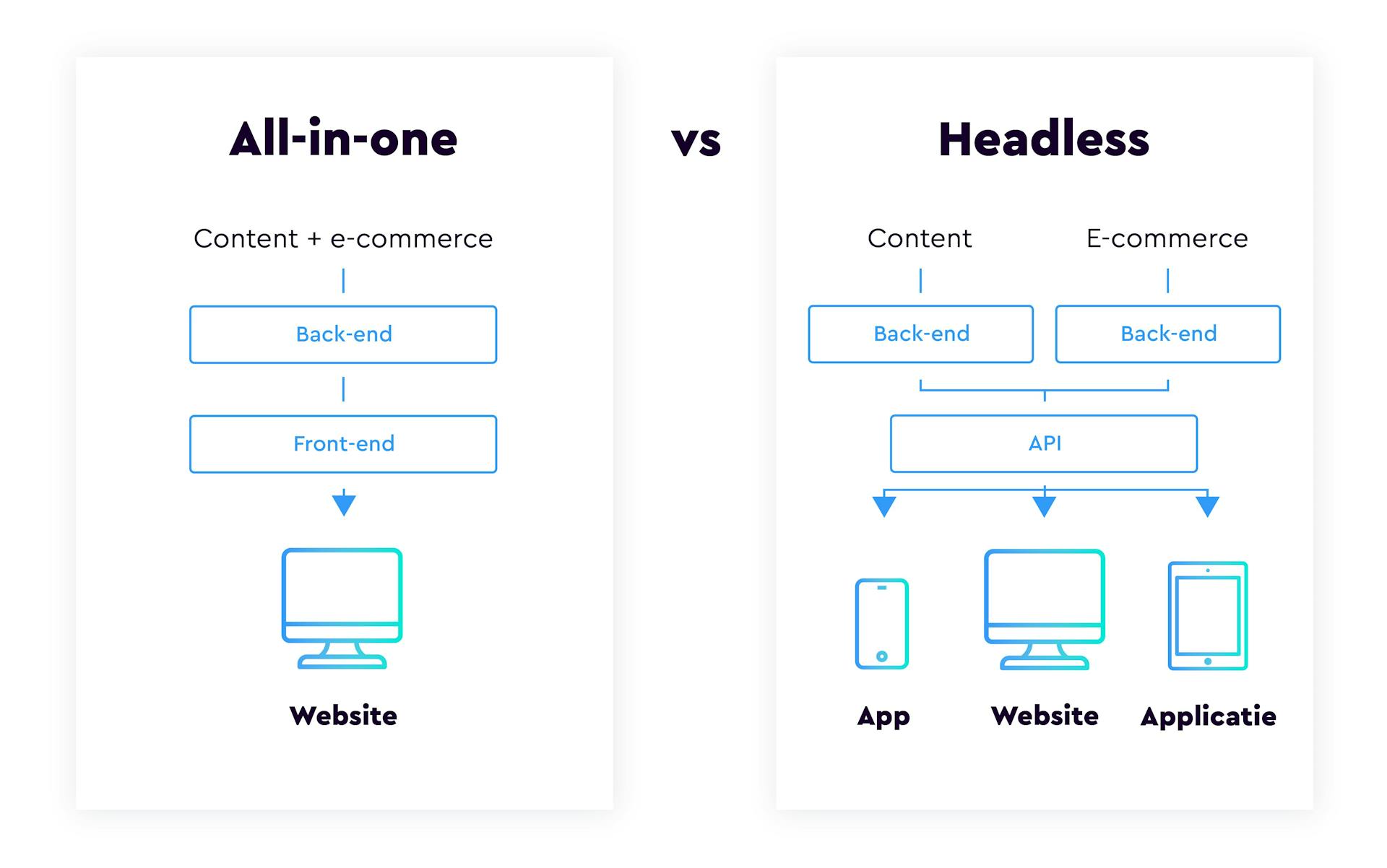Headless commerce: fast, flexible and scalable
Theme or template based, all-in-one, headless commerce, composable commerce; terms that come up regularly when you're a brand or retailer exploring the possibilities for a new commerce platform. But what do these terms mean, where is the dividing line and what fits which commerce strategy? In this article, we discuss the differences between an all-in-one platform and headless commerce, the pros and cons and why we think headless is the future.
All-in-one commerce vs. headless commerce
It sounds perfect, and often it is: an all-in-one commerce platform. A platform that offers everything you need to realize online ambitions: from order fulfillment to cms functionality, a 'my account' environment, shipping options, search and navigation features. For the most part in predefined templates that give implementation a kick-start. Important feature: the backend and frontend are directly integrated with each other. XSARUS itself works with the commerce platforms of Magento Open Source, Adobe Commerce and Shopware, which are very complete. The standard functionalities in these platforms are so extensive that, apart from integrations and templates, almost no custom development is required in the core.
But the world of e-commerce never stands still. Just as we went from Web 2.0 to 3.0, then to mobile Web sites and responsive Web design, we are now in the trend of headless commerce: a setup where the backend and frontend are precisely not directly integrated with each other.
Headless commerce: what is it?
In a headless setup, the backend of the commerce platform communicates with the frontend through APIs. Specifically, this means that the e-commerce platform is used only as a backend application. The data available to the backend is communicated with the frontend through an API, and vice-versa.

One of the most important parts of a headless commerce setup is the CMS. Whereas in an all-in-one solution a CMS is 'baked in' to the platform and therefore front and back end are tied together, with headless this is different: a CMS is needed, which can function headless. Can you use that 'embedded' CMS from an existing platform headless as well? In theory, yes. But is this desirable? Usually not. The existing CMS in an all-in-one platform is mainly focused on a web shop environment. Think of the homepage, landing pages and the well-known service section. When you want to present more inspirational content, such as a blog, trends and product applications, or direct more specific content toward in-store screens or a mobile app, a lot of customization quickly comes into play. A headless, stand-alone CMS offers many more options in this regard.
Headless commerce: the benefits
Shorter load time, or better performance.
One of the most obvious benefits of a headless setup is performance. Only what is needed for presentation at a given time on a given device is loaded and presented on the frontend. A positive side effect of this, is a possible savings in hosting costs. Fewer servers are needed to continuously build the pages.
- Flexibility and stability.
In an all-in-one platform, making a change takes quite a bit of effort. A small change in the frontend, for example as a result of an A/B test, causes the entire deployment cycle of the platform to have to be gone through. In a headless setup, only the frontend application is replaced, so no changes need to take place in the backend. This also reduces the chance of errors, leading to more stability. - Responding to the latest technology.
Related to point 2: By working with APIs, new frontend technologies can be implemented quickly without affecting the backend. - Personalization and customer experience.
Because of the unlimited freedom in the frontend, there is more room for personalization and customer experience. Because you are not tied to the standard templates and the syntax in which they are built, there is complete creative freedom and you can tailor the experience precisely to the visitor. You can also engage external tools much more easily, as well as seamlessly, for personalization, for example.
Disadvantages of headless commerce
Of course, a headless setup does not have only advantages. There are certainly aspects, which require proper consideration. For example, an all-in-one platform is often faster up-and-running than a headless environment. Simply because in an all-in-one platform much is already predefined. In a headless setup, the frontend is a custom job. The frontend still needs to be created and optimized for each device and touchpoint. Logically, the initial investment for this is higher because of the labor intensity. However, among the advantages, see point 2: due to the flexibility and freedom in the frontend, a lot of time will be saved during platform optimization.
Nevertheless, a headless setup does not always have to be a time-consuming development job. Based on best practices and a clearly defined strategy beforehand, a headless setup can sometimes stand as quickly as an all-in-one solution. Everything hinges on proper preparation and clearly articulating the requirements.
Getting started with headless commerce
When is a headless commerce setup a good fit? This obviously depends on the requirements, also with an eye to the future. Our consultants are happy to think along with you about required functionalities and challenges. Contact us at with no obligation, we would be happy to help you get started.
One step further: composable commerce
Already mentioned in the introduction to this article: composable commerce. As it were, the step after headless. You can read what composable commerce entails and what benefits it brings here.

